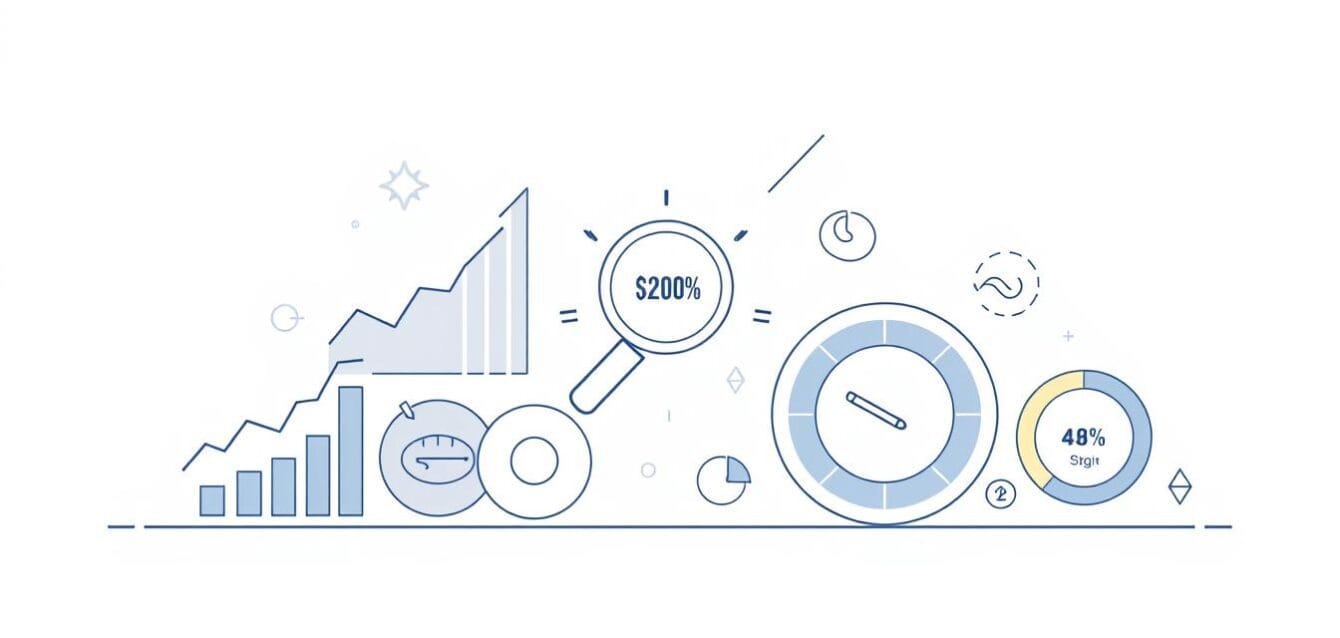Only 23% of marketers say they track the right KPIs — and the cost of being wrong is real: wasted budget, missed growth, and competitors compounding advantage.
We open with a simple thesis: align every indicator to revenue, not vanity. Our roadmap pairs funnel stage scorecards with trusted benchmarks so leaders can move from optics to outcomes.
At Awareness, measure impressions and quality traffic. In Consideration, watch engagement and time on site. At Decision, focus on conversion rate and revenue per acquisition.
We bring precise definitions, formulas, and thresholds for CAC payback, ROAS, CLV, and churn. This is a revenue-first scorecard for premium brands that demand repeatable, scalable results.
Keep reading to get the benchmark-driven playbook, governance rules, and the practical steps to translate data into board-level impact. When you’re ready, we’ll walk you through Macro Webber’s Growth Blueprint and consultation to lock in measurable ROI.
Key Takeaways
- Only 23% of marketers trust their KPIs—tie measures to revenue.
- Use funnel-stage scorecards: Awareness, Consideration, Decision.
- Prioritize CAC payback, ROAS, CLV, and conversion rate thresholds.
- Guard against vanity reporting and platform over-attribution.
- Establish ownership, cadence, and iteration rules for your scorecard.
The present reality: Most marketers track the wrong KPIs—here’s how to fix it
Too many programs report activity, not outcomes — and leaders are paying the price. Only 23% of marketers say they track the right KPIs. DMA data shows a 39% tilt toward vanity and 34.2% that skip ROI entirely.

The cost of guessing
Systems that reward motion over value drain budget and slow growth. We must replace anecdotes with rules that link every measure to revenue causality.
Map KPIs to funnel stages
Executive-grade scorecards start with the funnel, not the platform. Below is a compact map to align KPIs, owners, and intent.
| Funnel Stage | Example KPI | Purpose | Owner |
|---|---|---|---|
| Awareness | Qualified traffic, brand-search lift | Calibrate reach vs. true interest | Brand Lead |
| Consideration | Time on site, pages/session, social interactions | Measure depth and message fit | Content Lead |
| Decision | Conversion rate, sales revenue, SQLs | Translate activity into pipeline | Growth Lead |
- Normalize data across platforms to create one source of truth.
- Assign owners, targets, and a weekly review rhythm for each KPI.
- Retire measures that do not change decisions; prioritize those that forecast results.
We reframe dashboards into decision engines so leadership regains trust and teams improve effectiveness at scale.
Metrics vs KPIs: Avoid vanity traps and align with revenue outcomes
Leaders win when they focus on a handful of KPIs that map directly to revenue. We separate telemetry from what actually moves the business.

Not every metric is a KPI. A metric tracks a specific event—visits, clicks, or time on page. A KPI is the small set of numbers leaders use to judge strategy: conversion rate, CAC, CLV, and return on ad spend.
What to elevate vs what to monitor
- Elevate as KPIs: conversion rate, CAC, ROAS/ROI, CLV, payback — these link directly to revenue and value.
- Use as diagnostics: impressions, CTR, bounce, page speed — they explain why a KPI moved.
- Set acceptance criteria: material to revenue, team-controllable, and predictive of results.
Holistic measurement to stop platform bias
We unify data across platforms, de-duplicate conversions, and reconcile orders with finance. Replace last-click myths with multi-touch windows that match your sales cycle.
Operational rule: give every KPI an operating range and an action playbook. When a number breaches a threshold, the playbook triggers a specific test or shift in campaigns and budget.
Awareness KPIs that actually move pipeline, not just likes
Not all attention is equal. We measure visibility only when it ties to qualified interest. Impressions are a reach proxy — not a conversion.
Caveat: bots can drive ~40% of web traffic. Validate impressions with human-traffic filters and viewability checks before treating the number as real users.
Search and organic visibility that scale demand
Prioritize keyword coverage across buying-intent clusters, authoritative backlinks, and domain authority. Rising ranks should align with qualified sessions and goal completions on your website.
When to push branded vs generic terms
Search Impression Share = (Impr. received ÷ Impr. eligible) × 100. Max out branded share to defend demand. Scale generic terms only when conversion and ROAS remain efficient.
“Treat impressions as a reach proxy; link visibility to downstream indicators—direct traffic, brand-search lift, and assisted conversions.”
| Signal | Action | Threshold |
|---|---|---|
| Impressions | Apply human filters; reconcile with analytics | Bot rate <40%; viewable ≥70% |
| Organic visibility | Expand keyword clusters; earn authoritative links | Top-10 share increases month-over-month |
| Search Impression Share | Defend branded; test generic with ROAS guardrails | Branded ≥90%; Generic scale if ROAS > target |
- Audit creative for product clarity; awareness must signal premium value.
- Throttle channels that inflate impressions but not pipeline.
Consideration-stage Performance Marketing Metrics
Consideration is where intent meets scrutiny—this stage separates curious users from qualified prospects. We focus on signals that predict funnel advancement and defend budget with clarity.
Click-Through Rate (CTR): Interpreting benchmarks across search and social
Read CTR in context. Search often posts higher CTRs—expect ~3–7% as a practical range. Display and social typically sit below 1%.
Segment by branded vs generic queries and by audience cohort. A single number hides optimization chance.
Cost per Click (CPC): Budget efficiency and auction dynamics
CPC = total cost ÷ clicks. Lowering bids is not the only lever.
Improve relevance, tighten match types, and prune negatives. Auctions reward better fit and punish noisy bids. If CPC rises without gains in conversion rate or downstream value, pause and test creative or audience exclusions.
Engagement and On-site Quality
Track time on site, pages per session, and bounce to judge consideration strength. Rising depth predicts more micro-conversions and assists.
High CTR with poor engagement signals a message-page mismatch. Use cost per frameworks—cost per engaged session or cost per view content—when the sales cycle is long.
- Guardrail: campaign CPC should align with expected cost per micro-conversion.
- Prioritize creative that clarifies offer fast to reduce wasted clicks.
- Maintain a hypothesis backlog (headline, angle, proof) and test to move defined rate or cost KPIs.
Conversion efficiency: From clicks to customers
Turning clicks into customers requires clear definitions and surgical execution. We define conversions as commercial actions that matter: purchases, qualified demo bookings, and revenue-significant signups. These are the events that drive value and funding decisions.
Conversions and conversion rate: GA4 definitions and landing-page fit
In GA4, mark only revenue-aligned events as conversions. Tag purchases, qualified demos, and verified leads. Avoid vanity events that inflate dashboards.
Conversion rate = conversions ÷ visitors. Track by device, geo, audience, and creative to reveal the true levers.
Diagnose landing-page fit with message continuity, speed, short forms, and clear trust signals. Fix the biggest leak first for the fastest lift.
Cost per conversion and CPL: offers, creative, and funnels
Cost per conversion = spend ÷ conversions. When the conversion is a lead, CPL equals that cost.
- Evaluate unit economics: cheap leads that don’t become customers destroy ROI.
- Instrument micro-conversions to map drop-offs and prioritize fixes.
- Run structured A/B tests on offers and creative to move conversion metrics by double digits.
- Use native integrations like like Google Analytics and server-side tracking to reconcile platform counts with GA4 events.
“Conversion metrics must translate into improved customer economics, not just prettier dashboards.”
Financial impact metrics executives care about
When leadership asks for impact, they mean profit, payback, and predictable revenue. We translate operational signals into finance-grade KPIs so the company can allocate capital with confidence.
Customer Acquisition Cost (CAC): full-cost view and channel mix
CAC = (sales + marketing cost) ÷ customers acquired. Include media, tools, agency fees, and headcount so channel comparisons are honest.
Tie sales velocity and close rates to each source. Cheap leads that don’t convert inflate true acquisition cost and reduce value.
ROAS vs ROI: read them together
ROAS = revenue ÷ ad spend. Use it for channel efficiency. ROI includes profit and fixed costs and should drive strategic choices when company-level profitability matters.
CLV and payback, plus subscription health
CLV = average customer value × average lifespan. Model conservatively, test with cohorts, and calculate Time to Payback CAC in months. Shorter payback accelerates reinvestment.
For subscriptions, watch MRR growth and churn rate. Rising ARPU with stable retention signals durable product-market fit.
| Metric | Formula | Use |
|---|---|---|
| CAC | (Sales + marketing cost) ÷ customers | Channel unit economics |
| ROAS | Revenue ÷ ad spend | Channel efficiency |
| CLV | Avg. order value × lifespan × margin | Budget cadence, bid to CLV |
| Payback | Months to recoup CAC | Reinvestment timing |
“Cost, revenue, return, and time—measured, compared, and optimized for category leadership.”
Performance Marketing Metrics: Benchmarks, tools, and workflows
We set guardrails so every campaign turns data into decisive action. Start with pragmatic ranges, then lock tooling and cadence so teams move fast and clean.
Benchmarks to start
Use these as sanity checks, not absolutes. Search CTR typically sits between 3–7%. Display and programmatic creative often fall under 1% (~0.6%). A ROAS above 1 shows top-line return but must be reconciled with margin and sales cycle.
Tooling stack
We standardize on like google analytics (GA4) for event and conversion governance, Google Ads for auction controls, and SEO suites for rankings and backlinks. Aggregate platform exports into one warehouse to prevent over-attribution.
Reporting cadence & governance
Declare objectives and goals before spend. Run a weekly operating rhythm: KPI reviews, hypothesis sprints, and budget reallocations tied to movement in the number that matters.
| Area | Recommended Range | Tooling |
|---|---|---|
| CTR (search/display) | 3–7% / <1% | Google Ads, SEO suites |
| ROAS | >1 (adjust to margin) | GA4, ad platforms |
| CAC : CLV | Model per cohort; protect margin | Data warehouse, CRM |
“Build a single source of truth, codify tests, and validate conversions against backend orders before scaling any advertising budget.”
Conclusion
The difference between growth and noise is a single, reconciled scorecard that leaders trust. With only 23% of teams confident in their KPIs and 34.2% skipping true ROI, the cost of guesswork is real.
We prescribe funnel alignment, holistic measurement, and fiscal rigor so every spend links to revenue. This removes platform over-attribution and lets unit economics compound.
High-ticket growth demands discipline: CAC, CLV, ROAS, ROI, churn, and payback become operating language—not occasional checks. We implement scorecards, data consolidation, benchmarks, tests, and executive reporting end-to-end.
Act now: secure Macro Webber’s Growth Blueprint and lock your slot this quarter. Book a consultation to quantify upside in dollars; we’ll forecast payback and build the roadmap to outpace your market.



